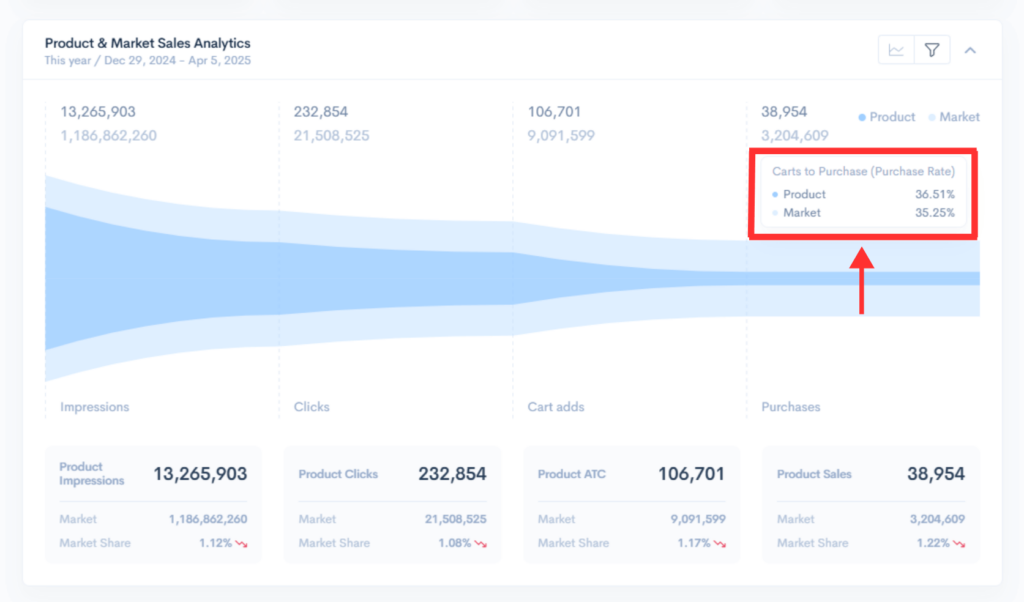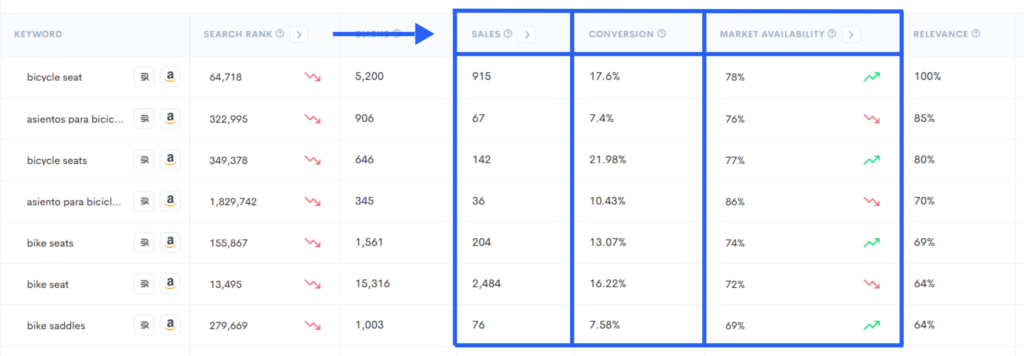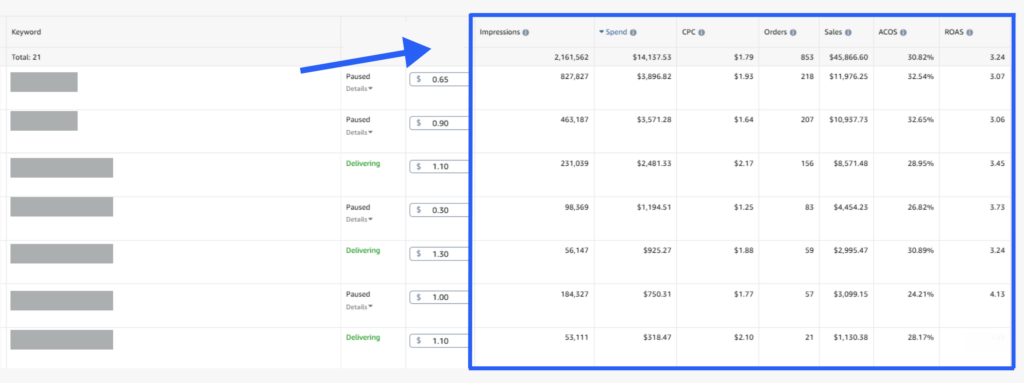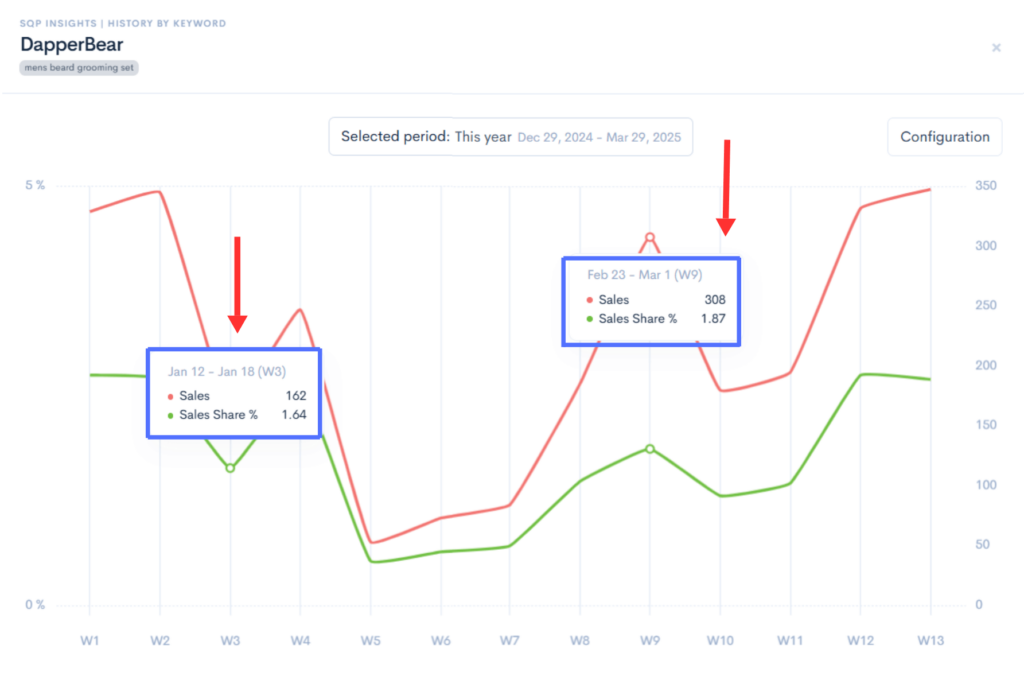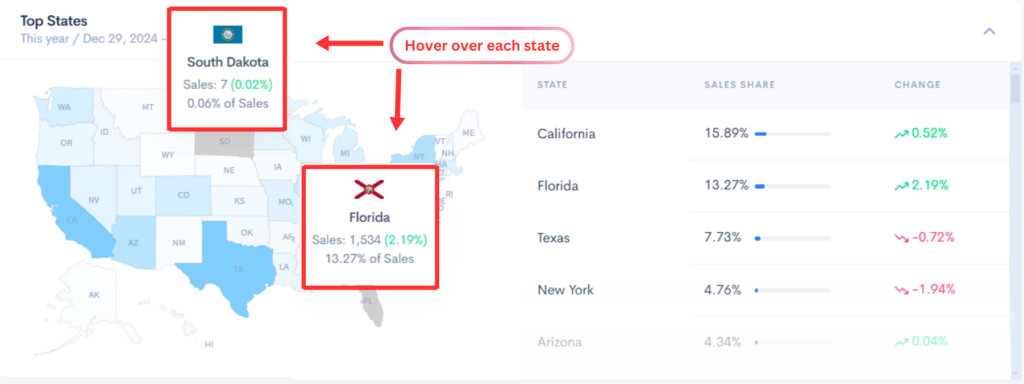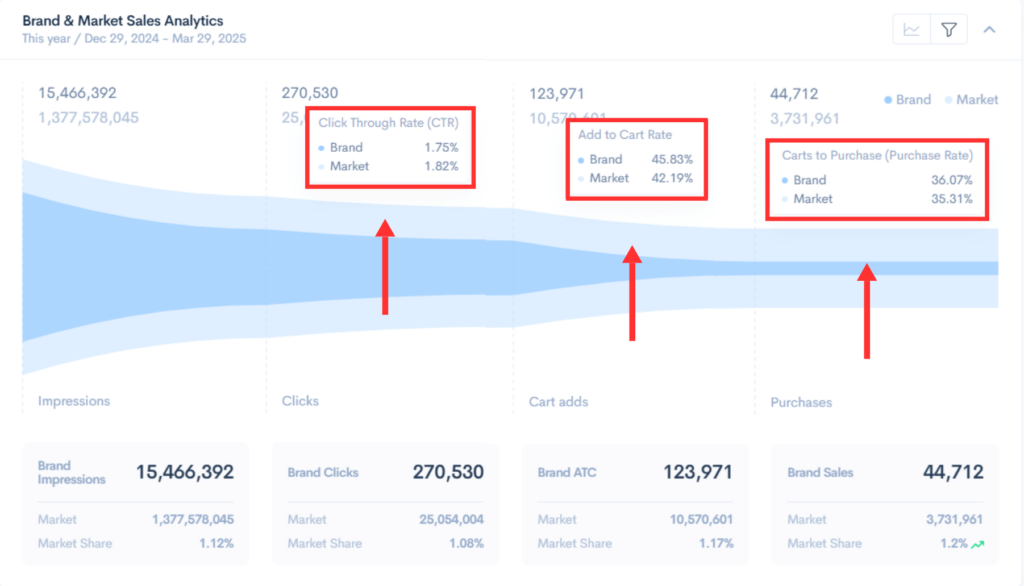How to Predict Which Keywords Will Bring the Most Sales Before You Invest
Sellerise Team, Contributor
10 min read -
Updated:Selling on Amazon’s global e-commerce marketplace may seem like a no-brainer to make profits, till you discover just how competitive and complex it is to secure the top spot in search results. Strategic bidding on the sales-making keywords that place your PPC ads in front of the correct customer is your not-so-secret weapon to sales success. But did you know that outdated bidding strategies can minimize the ROI on your spending?
The key to cracking the Amazon PPC bidding code lies in data-driven keyword forecasting. Discover the best way to use predictive analysis and trend forecasting to streamline your keyword bids today.
Why Reactive Keyword Strategies Fail
While Amazon offers dynamic features and tools to help sellers secure a place in the spotlight, reactive keyword bidding strategies do not deliver results.
Aggressively bidding on high-volume keywords is passé. You may instinctively spend on high-volume keywords but remember that they are broadly targeted and too expensive to acquire. High-volume keywords can potentially increase your search result ranking but come with the risk of higher ad spend and lower ROI.
Even veteran Amazon sellers may struggle to get good cost-per-click (CPC) from high-volume keywords because of the above reasons. It makes little sense to bid on them if you’re new to Amazon PPC or do not have a huge ad budget.
Why?
A high volume does not equal a high conversion rate.
Besides, search terms used by customers keep changing in real time. High-volume keywords from last month do not offer you any competitive advantage at present.
The best approach to finding high-converting keywords is to take a proactive instead of a reactive approach. That simply means relying on real-time data and state-of-the-art predictive analytics to find keywords that have higher probability of conversion.
There is no shortcut to keyword success. However, you can work smarter to get better results.
Here’s how you can get started:
#1 Analyze Search Term Behaviour with Funnel Metrics
Buyer intent determines search term behavior. It includes all the different ways a potential customer searches for a product before purchasing a product. So, analyzing search term behavior can give a competitive edge when you bid for keywords.
The best way to do that is to focus on funnel metrics so that you can cover all the touchpoints of a customer search query — from how they search and what links they click to what they buy and from whom.
Luckily for you, Sellerise SQP Insights data gives you an exhaustive update for all the touchpoints mentioned above. It covers impressions, clicks, cart adds, purchases, and overall percentage of your business’s share for any given search term.
The SQP Insights offers a granular as well as a broader generalistic overview of ASIN view that gives you an overview of search query performance for a specific ASIN.
This dashboard displays data from Amazon’s search result page and does not include insights from product details pages or widgets. That said, it’s crucial to study how a potential buyer interacts with search keywords.
Here’s a quick guide to getting started.
Best Practices in Funnel Performance Analysis
- Identify High-Performing Keywords: Shortlist keywords that have proven conversion potential irrespective of their type. It should include broad match, phrase match, and exact match keywords. Even negative keywords are useful because they can prevent your product listings from showing up in irrelevant searches.
- Flag Underperformers: Segment keywords that get clicks but do not lead to conversions. Such keywords may be good for discoverability but do not contribute to the goal of increased sales.
- Spot Hidden Opportunities: As mentioned earlier, high-volume keywords do not necessarily equate with high conversion rates. Focus on keywords with moderate search volumes that convert.
- Diagnose Funnel Drop-offs: Studying the sales funnel closely should give you clarity over where you’re losing your customers. Identifying these touchpoints could help you streamline your keyword strategy. Common places where customers drop off include:
– Add-to-Cart → Purchase drop-off
– Click → Cart drop-off
– Impression → Click drop-off
The Amazon Search Query Dashboard is available to all sellers enrolled in the Amazon Brand Registry.
Alternatively, you can utilize Sellerise SQP Insights to optimize your Amazon sales funnel. It gives you a complete overview and analysis of your keyword performance. Track key metrics like impressions, clicks, add-to-cart rates, purchases, and market share.
Sellerise SQP Insights visualizes data for you so that you can easily study what’s working and eliminate what’s not. You can use it to pinpoint keywords that were driving conversions in the past but are currently ineffective.
#2 Forecast Keyword Conversion Potential and Profitability
When selecting keywords to bid, the key metric you should watch out for is its conversion potential.
Why?
Because conversion potential is directly proportional to profitability and good ROI on bid spends.
Calculating (or rather forecasting) keyword conversion potential is easy. You need to study three key metrics, which include:
– Search volume trends
– Historical conversion data
– CPC data
Sellerise’s Keyword Hunter Pro helps you find keywords that you can use to optimize your product listings, improve search result rankings, and drive more sales. The 40 million+ database is updated every week in real time to allow you to spot trending keywords and comes with a lightening fast search speed. You can analyze the sales of each keyword and their competition level; and find the ones with the highest conversion potential.
Stepwise Guide to Effectively Calculating Keyword Profitability
1. Use Amazon’s automated suggested bids to estimate CPC of chosen keywords;
- Calculate clicks per sale;
- Compare ACoS to the profit margin of the product you’re selling.
Once you’ve shortlisted the keywords you should invest in, do not forget to track their performance. To track conversion potential, focus on:
– Conversion Rate (CVR): This calculates the total number of customers who make a purchase after clicking on your PPC ads;
– Click Through Rate (CTR): This refers to the percentage of customers who click on your PPC ad when it shows up in the Search Results;
– Advertising Cost of Sales (ACoS): This is the percentage of money spent on running ads as compared to the sales generated from them;
– Return on Ad Spend (RoAS): This is the revenue generated from PPC ads divided by the total money spent on it.
Make use of spreadsheets to analyze the data you have collected. Use the insights to make future decisions.
#3 Study Historical Trends and Perform Seasonality Analysis
One of the biggest mistakes you can make when selling on Amazon is to assume that keyword forecasting is a one-time thing. It’s dynamic and changes in the blink of an eye, thanks to fluctuating consumer demands. Keyword performance is subject to change.
That’s why you need to analyze historical trends.
A proactive keyword strategy that takes into account historical and real-time data is what you need to ensure the money spent on keyword bidding yields a good ROI. Historical trend analysis helps you identify:
– The performance lifetime of keywords;
– Emerging trends in consumer purchase habits;
– Seasonal changes, especially during holidays.
Each of these play a crucial role in ascertaining the relevance and therefore the effectiveness of the keywords. Whether you want to optimize your product listings or bid on keywords for your PPC ad campaign, having a clear understanding of historical data is non-negotiable in driving conversions.
What can you do to avoid making mistakes?
Perform Historical Chart Analysis
You can utilize the Sellerise SQP Insights tool to study keyword trends for a duration of 12 months. The dashboard tells you which keywords have performed the best, allows you to spot emerging trends, and locate lost keywords.
Find the keywords that have shown the most conversion potential specific to your niche and update your strategy based on data-backed insights.
Understand that data is your best friend and key enabler when it comes to trend analysis. Sellerise’s tools simply allow you key insights that help you take data-driven decisions.
Study Cluster-Level Trends:
Cluster-level trend analysis is the technique of grouping related keywords. It can be of many types, by region, by seasonality, by performance, etc.
Why does it matter?
Clustering allows you greater freedom in understanding consumer search and purchase behavior. Clustering is also beneficial in identifying geographical regions of your paying customers and their purchasing patterns.
Studying cluster-level trends gives you granular insights which you can utilize to predict keywords that will drive the most conversions, even in a highly dynamic and competitive online marketplace like Amazon.
While chasing after high search volume keywords is a generic approach to keyword analysis, cluster-level trend analysis is highly accurate and delivers more definitive outcomes in Amazon sales.
Observe External Signals
To ensure your keyword strategy is even more foolproof and relevant, you need to look beyond Amazon.
One of the best places to do your research is to monitor Google Trends for your exact and related niches. Social media is also helpful in this regard, especially since the explosive growth of social commerce.
External signal monitoring expands your view, helping you implement targeted keyword strategies that are bound to yield a good ROI.
Getting better sales even in competitive niches is a cumulative outcome of all the factors and best practices mentioned above. It’s not a singular tactic.
#4 Perform Competitor Analysis to Reverse Engineer Keyword Success
Another smart way of predicting keywords that have the potential to boost sales is to study your competition as closely as possible. When it comes to increasing sales, competitor analysis has two key benefits:
– It gives you crucial information that you can utilize to optimize your product listings that goes beyond just keywords;
– It helps you spot keyword opportunities that have worked for other sellers in the same niche.
By closely studying your direct, indirect, and SERP competitors, you can analyze every part of the listing for keyword usage. This includes the title, bullet points, product descriptions, backend keywords, and alt text for images.
The data you gather can easily be used to reverse engineer your keyword strategy.
In addition, you can also analyze keywords that didn’t perform well for other sellers in the same niche and avoid them. It teaches you what to and more importantly, what not to do when bidding on keywords or optimizing your listings.
Key Areas of Focus in Competitor Analysis
If you’re new to it or unaware of where to start, focus on:
1. Identifying and Finding Overlaps and Gaps: Perform end-to-end competitor analysis that tells you which keywords are common in your optimized listings and which ones are amiss from yours. You can later analyze the missing keywords to understand if they will add value to your listings.
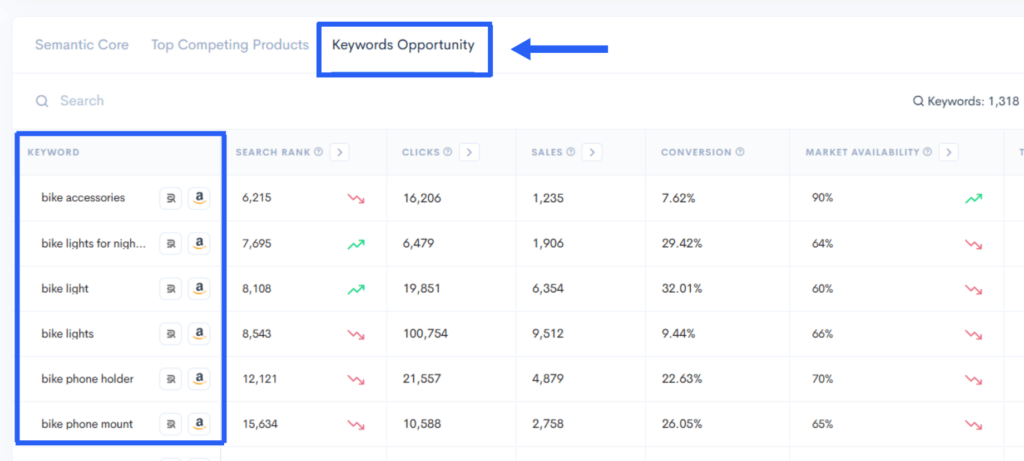
- Finding Blind Spots: The indiscriminate use of high-volume keywords leaves many high-performing keywords unutilized. Competitor analysis is an excellent method to identify hidden keyword opportunities that have high conversion potential for your niche but are not being used by other sellers. Using such keywords gives you a major competitive advantage with Amazon’s algorithm.
- Assessing Competitor Strength: You should also use this opportunity to do a SWOT analysis of your competitors. Find out their ranking and conversion metrics and replicate it for your own listings.
You will need technological help to get it done and that’s where Sellerise Keyword Re-Ranker Pro proves to be extremely helpful.
It’s a next-gen competitor analysis tool that scours a 37 million+ ASIN database to give you a comprehensive overview of other sellers in the same niche. The tool shows the list of keywords your competitors use to rank high on Amazon.
One of the key features of this tool is finding high-sales low competition keywords that can easily boost your rankings in the search results page.
Sign up for a 7-day free trial to check the tool today.
#5 Detect High Lifetime Value (LTV) Keyword Opportunities
Not all keywords are the same! So, last but not least, work on finding high lifetime value (LTV) keyword opportunities.
The profitability of such keywords is evergreen, not seasonal. Instead, they retain their conversion potential for a significant period of time. That means the same set of keywords convert into new and repeat purchases. Some may even amount to bigger spending from customers.
If long-term profitability is your goal and you want to attract sales all year round, you must invest in high LTV keywords.
Stepwise Guide to Spotting High LTV Keywords
So how to find such keywords which can generate sales via year-long purchases from different types of old and new customers? Check out the following proven tactics:
1. Cohort Analysis: Use SQP Insights to analyze consumer behavior and get insights on their purchase patterns for specified keywords. Cohort analysis can detect users who engage with certain keywords specific to your niche, brand, or product feature. It provides crucial insights about a customer’s search to purchase journey.
2. Customer Loyalty Analytics: Amazon offers a Customer Loyalty Analytics dashboard that provides data about repeat purchases, high-value demographics, and market trends. You can use this dashboard to increase customer lifetime value (CLV) and boost sales.
3. Amazon Marketing Cloud: Amazon Marketing Cloud (AMC) is a cleanroom solution that allows you to study insights pertaining to your PPC ads. You can use your existing ads as inputs to create customized audience lists for your campaigns, guided by the historical data of consumer behavior. Simply put, it gives you greater control over campaign optimization to drive results.
It’s a cloud-based feature that offers unparalleled data security and privacy for your benefit.
4. Product Targeting: Product targeting gives you the opportunity to choose specific products, categories, brands, or other product features related to the one in your PPC ad. You can use a combination of individual and group-based targeting to increase the visibility of your product. Try to aim for complementary items that have high repeat purchase intent to boost your sales.
This methodology is extremely helpful in increasing the discoverability of your products in the search results page and also in the product details page.
It allows you to showcase your products at two different touchpoints, therefore increasing the chances of conversion.
Ditch Guesswork to Increase Your Chances of Selling
As one of the largest and leading e-commerce marketplaces on a global scale, Amazon can provide you with an excellent opportunity to generate revenue. However, a closer look reveals that becoming a profitable seller is not easy. You need strategic planning and technological support to beat the competition and excel.
Guesswork and blindly following fads will not work in your favor.
Focusing on holistic keyword research and strategic execution are key to Amazon success.
So, transform your Amazon business into a profitable one. Follow the approach outlined in this article and let Sellerise help you become successful.
Get started today.

